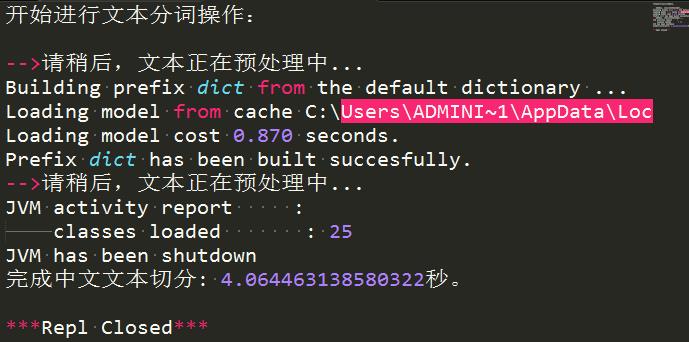结巴分词和自然语言处理HanLP处理手记
tags:
篇首语:本文由小常识网(cha138.com)小编为大家整理,主要介绍了结巴分词和自然语言处理HanLP处理手记相关的知识,希望对你有一定的参考价值。
手记实用系列文章:
3 自然语言处理手记
代码封装类:
#!/usr/bin/env python
# -*- coding:utf-8 -*-
import jieba
import os
import re
import time
from jpype import *
\'\'\'
title:利用结巴分词进行文本语料的批量处理
1 首先对文本进行遍历查找
2 创建原始文本的保存结构
3 对原文本进行结巴分词和停用词处理
4 对预处理结果进行标准化格式,并保存原文件结构路径
author:白宁超
myblog:http://www.cnblogs.com/baiboy/
time:2017年4月28日10:03:09
\'\'\'
\'\'\'
创建文件目录
path:根目录下创建子目录
\'\'\'
def mkdir(path):
# 判断路径是否存在
isExists=os.path.exists(path)
# 判断结果
if not isExists:
os.makedirs(path)
print(path+\' 创建成功\')
return True
else:
pass
print(\'-->请稍后,文本正在预处理中...\')
\'\'\'
结巴分词工具进行中文分词处理:
read_folder_path:待处理的原始语料根路径
write_folder_path 中文分词经数据清洗后的语料
\'\'\'
def CHSegment(read_folder_path,write_folder_path):
stopwords ={}.fromkeys([line.strip() for line in open(\'../Database/stopwords/CH_stopWords.txt\',\'r\',encoding=\'utf-8\')]) # 停用词表
# 获取待处理根目录下的所有类别
folder_list = os.listdir(read_folder_path)
# 类间循环
# print(folder_list)
for folder in folder_list:
#某类下的路径
new_folder_path = os.path.join(read_folder_path, folder)
# 创建一致的保存文件路径
mkdir(write_folder_path+folder)
#某类下的保存路径
save_folder_path = os.path.join(write_folder_path, folder)
#某类下的全部文件集
# 类内循环
files = os.listdir(new_folder_path)
j = 1
for file in files:
if j > len(files):
break
# 读取原始语料
raw = open(os.path.join(new_folder_path, file),\'r\',encoding=\'utf-8\').read()
# 只保留汉字
# raw1 = re.sub("[A-Za-z0-9\\[\\`\\~\\!\\@\\#\\$\\^\\&\\*\\(\\)\\=\\|\\{\\}\\\'\\:\\;\\\'\\,\\[\\]\\.\\<\\>\\/\\?\\~\\!\\@\\#\\\\\\&\\*\\%]", "", raw)
# jieba分词
wordslist = jieba.cut(raw, cut_all=False) # 精确模式
# 停用词处理
cutwordlist=\'\'
for word in wordslist:
if word not in stopwords and word=="\\n":
cutwordlist+="\\n" # 保持原有文本换行格式
elif len(word)>1 :
cutwordlist+=word+"/" #去除空格
#保存清洗后的数据
with open(os.path.join(save_folder_path,file),\'w\',encoding=\'utf-8\') as f:
f.write(cutwordlist)
j += 1
\'\'\'
结巴分词工具进行中文分词处理:
read_folder_path:待处理的原始语料根路径
write_folder_path 中文分词经数据清洗后的语料
\'\'\'
def HanLPSeg(read_folder_path,write_folder_path):
startJVM(getDefaultJVMPath(), "-Djava.class.path=C:\\hanlp\\hanlp-1.3.2.jar;C:\\hanlp", "-Xms1g", "-Xmx1g") # 启动JVM,Linux需替换分号;为冒号:
stopwords ={}.fromkeys([line.strip() for line in open(\'../Database/stopwords/CH_stopWords.txt\',\'r\',encoding=\'utf-8\')]) # 停用词表
# 获取待处理根目录下的所有类别
folder_list = os.listdir(read_folder_path)
# 类间循环
# print(folder_list)
for folder in folder_list:
#某类下的路径
new_folder_path = os.path.join(read_folder_path, folder)
# 创建一致的保存文件路径
mkdir(write_folder_path+folder)
#某类下的保存路径
save_folder_path = os.path.join(write_folder_path, folder)
#某类下的全部文件集
# 类内循环
files = os.listdir(new_folder_path)
j = 1
for file in files:
if j > len(files):
break
# 读取原始语料
raw = open(os.path.join(new_folder_path, file),\'r\',encoding=\'utf-8\').read()
# HanLP分词
HanLP = JClass(\'com.hankcs.hanlp.HanLP\')
wordslist = HanLP.segment(raw)
#保存清洗后的数据
wordslist1=str(wordslist).split(",")
# print(wordslist1[1:len(wordslist1)-1])
flagresult=""
# 去除标签
for v in wordslist1[1:len(wordslist1)-1]:
if "/" in v:
slope=v.index("/")
letter=v[1:slope]
if len(letter)>0 and \'\\n\\u3000\\u3000\' in letter:
flagresult+="\\n"
else:flagresult+=letter +"/" #去除空格
# print(flagresult)
with open(os.path.join(save_folder_path,file),\'w\',encoding=\'utf-8\') as f:
f.write(flagresult.replace(\' /\',\'\'))
j += 1
shutdownJVM()
if __name__ == \'__main__\' :
print(\'开始进行文本分词操作:\\n\')
t1 = time.time()
dealpath="../Database/SogouC/FileTest/"
savepath="../Database/SogouCCut/FileTest/"
# 待分词的语料类别集根目录
read_folder_path = \'../Database/SogouC/FileNews/\'
write_folder_path = \'../Database/SogouCCut/\'
#jieba中文分词
CHSegment(read_folder_path,write_folder_path) #300个txtq其中结巴分词使用3.31秒
HanLPSeg(read_folder_path,write_folder_path) #300个txt其中hanlp分词使用1.83秒
t2 = time.time()
print(\'完成中文文本切分: \'+str(t2-t1)+"秒。")
运行效果:

以上是关于结巴分词和自然语言处理HanLP处理手记的主要内容,如果未能解决你的问题,请参考以下文章